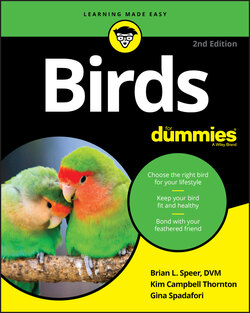Читать книгу Birds For Dummies - Gina Spadafori - Страница 66
Telling the Girls from the Guys
ОглавлениеWhich do you prefer — a male bird or a female? Does gender really matter? How can you tell the males from the females, anyway?
Selection of one sex or the other depends on the qualities you’re seeking in your new family member. If you’re buying a canary and you want a singer, a male is your choice. (And still, you should hear the bird sing before you buy him.) Male cockatiels are usually better whistlers than females, and the red and blue female Eclectus parrot is considered the real looker of her kind — much flashier than her green and red mate, although he’s not bad looking, either. In terms of health, females sometimes have obstetric problems, such as egg binding, where eggs get trapped inside, especially in smaller parrot species such as budgies, cockatiels, or lovebirds. And of course, the folks who breed birds have preferences: They don’t want to end up with all males or all females!
In many cases, though, gender makes no difference in terms of pet potential. The basics of caring for, training, and feeding a bird, as well as the bird’s intelligence, will be the same, male or female.
The sex of a pet bird is most commonly determined by DNA evaluation (see the nearby sidebar), although birds can also be surgically sexed, a procedure in which a veterinarian examines the animal under anesthesia in order to determine gender.
The term for males and females who don’t look alike is sexual dimorphism. Many species of birds don’t exhibit any differences, at least not as far as we mere humans can tell. Birds themselves can tell the difference, of course, although we don’t always understand how. We do know, however, that many birds can see a larger color spectrum than humans do, and likely, they can much more easily see the differences between genders.
Some species have gender identities that are obvious to human eyes. The Eclectus is certainly one of the more extreme examples — the male and female are so different that folks once believed the two genders were separate species — but other, more subtle differences exist in many species. An experienced seller can usually tell the girls from the boys in adult budgies, cockatiels, and some of the other parrot species where the colors are the same but the marking pattern is just a wee bit different, such as in the Senegal parrot.
In their quest for birds with that something special, some aviculturists have created a number of color varieties, in the process adding another level of confusion to the identification of some species. The classic example is the cockatiel. The common normal gray cockatiel is easy to sex: Males are gray, with bright orange cheeks and no white on the underside of their wing feathers. Females have gray heads with duller-colored orange cheeks and cross bars underneath their outer tail feathers and wing feathers.
